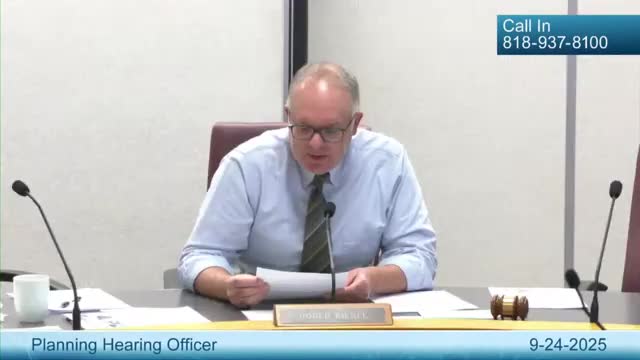Glendale Planning Officer Reviews Variance Requests for 1719 Gladys Drive Construction
September 24, 2025 | Glendale, Los Angeles County, California
This article was created by AI summarizing key points discussed. AI makes mistakes, so for full details and context, please refer to the video of the full meeting. Please report any errors so we can fix them. Report an error »

In the heart of Glendale's city hall, the Planning Hearing Officer convened on September 24, 2025, to address two significant discretionary permit applications that could shape the community's landscape. As the meeting commenced, Roger, the hearing officer, welcomed attendees and outlined the process for the day, emphasizing the importance of public participation through live broadcasts on Glendale TV and various streaming platforms.
The first case on the agenda focused on a proposed new single-family residence at 1719 Gladys Drive. This ambitious project, spanning approximately 2,200 square feet, seeks to establish a three-story home with an attached two-car garage on a vacant hillside lot. However, the application requires several variances and administrative exceptions, particularly concerning setbacks and standards due to the unique challenges posed by the hillside location.
City departments, including Public Works and Traffic Engineering, provided crucial feedback on the project, particularly regarding driveway access and the positioning of structures in the right-of-way. Their insights prompted revisions to the project plans, showcasing the collaborative effort between city officials and applicants to ensure safety and compliance.
Yet, not all feedback was positive. Concerns were raised about potential safety risks associated with falling debris, slope stability, and excavation practices. These issues highlight the delicate balance between development and environmental safety, as community members voiced apprehensions about the broader implications of approving such variances. The potential for setting a precedent regarding lot size, house height, and setbacks loomed large in the discussions, reflecting the community's desire to maintain its character while accommodating growth.
As the hearing progressed, the applicant was given the opportunity to present their case, followed by comments from supporters and opponents alike. Each speaker was allotted a brief window to express their views, ensuring a democratic process where all voices could be heard.
The meeting concluded with a reminder that decisions made during the hearing would be documented and communicated to all interested parties, with the possibility of appeals within 15 days. This structured approach underscores Glendale's commitment to transparency and community involvement in the planning process.
As the city navigates these complex applications, the outcomes will not only influence the immediate neighborhood but also set the tone for future developments in Glendale, a city striving to balance growth with the preservation of its unique hillside charm.
The first case on the agenda focused on a proposed new single-family residence at 1719 Gladys Drive. This ambitious project, spanning approximately 2,200 square feet, seeks to establish a three-story home with an attached two-car garage on a vacant hillside lot. However, the application requires several variances and administrative exceptions, particularly concerning setbacks and standards due to the unique challenges posed by the hillside location.
City departments, including Public Works and Traffic Engineering, provided crucial feedback on the project, particularly regarding driveway access and the positioning of structures in the right-of-way. Their insights prompted revisions to the project plans, showcasing the collaborative effort between city officials and applicants to ensure safety and compliance.
Yet, not all feedback was positive. Concerns were raised about potential safety risks associated with falling debris, slope stability, and excavation practices. These issues highlight the delicate balance between development and environmental safety, as community members voiced apprehensions about the broader implications of approving such variances. The potential for setting a precedent regarding lot size, house height, and setbacks loomed large in the discussions, reflecting the community's desire to maintain its character while accommodating growth.
As the hearing progressed, the applicant was given the opportunity to present their case, followed by comments from supporters and opponents alike. Each speaker was allotted a brief window to express their views, ensuring a democratic process where all voices could be heard.
The meeting concluded with a reminder that decisions made during the hearing would be documented and communicated to all interested parties, with the possibility of appeals within 15 days. This structured approach underscores Glendale's commitment to transparency and community involvement in the planning process.
As the city navigates these complex applications, the outcomes will not only influence the immediate neighborhood but also set the tone for future developments in Glendale, a city striving to balance growth with the preservation of its unique hillside charm.
View full meeting
This article is based on a recent meeting—watch the full video and explore the complete transcript for deeper insights into the discussion.
View full meeting
